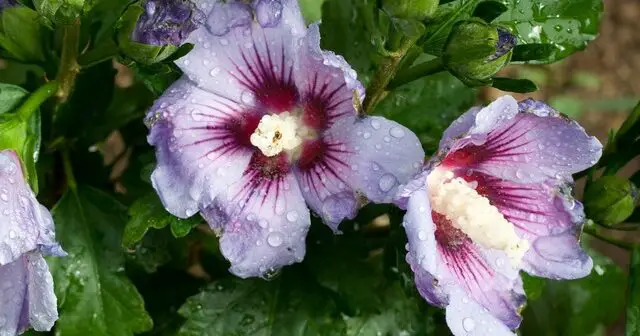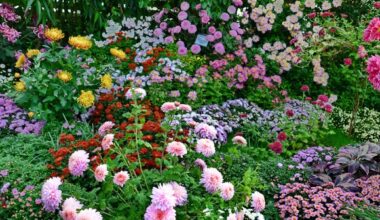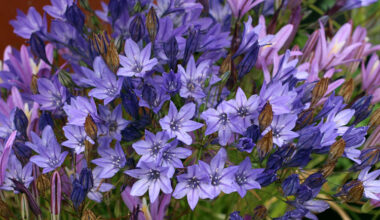Native to temperate Asia, it is the hardiest species of the Hibiscus genus, withstanding temperatures as low as -4°F without any problem. Its bright green leaves are alternate, oval and pointed, with irregularly toothed edges. They appear in late spring.
From June until frost, depending on the climate, the shrub flowers massively and continuously. The flowers of the hibiscus are solitary, 2 to 4 inches in diameter and appear in the axils of the leaves (they are said to be axillary). They are usually single in classic varieties, but in recent years, semi-double and double varieties have become popular with planter boxes.
Contents
The outdoor hibiscus
The hibiscus syriacus, more commonly known as Althea, is an easy and very flowering shrub, which can be advantageously placed anywhere in the garden. The multiplicity of its species, the beauty of its long and abundant flowering and its fast growth give it an undeniable attraction.
Deciduous shrub, it can however keep its leaves in winter in the most southern regions.
Its usually purple flowers have been the subject of many efforts to diversify their color, the hibiscus can nowadays present a pink, blue, red, white flowering, sometimes with a sliced heart. Its flowers, usually single, can be double in some varieties.
Where to plant hibiscus outdoors?
For a long and abundant bloom, place the hibiscus in full sun. Half-shade is possible in the South. Offer it a fertile, cool, but well-drained soil in winter. It tolerates limestone well.
Planting of hibiscus syriacus
Potted garden hibiscus
Throughout the year, the shrub must be planted in a special soil for flowering plants, planting or universal.
- Repotting in spring and every 2 years at the most in a slightly larger diameter pot.
Outdoor garden hibiscus
Prefer to plant your Althea in the fall, or in the spring if the shrub is sold in a pot or container.
- Prefer a place sheltered from the wind and especially well sunny.
- A well-drained soil prevents roots from swimming in water, especially in the spring and fall after heavy rainfall.
- Follow our tips for planting shrubs.
Hibiscus multiplication
Hibiscus syriacus cuttings are easy to make in spring.
You can also simply put stems cut in the spring directly into a vase of water and plant them as soon as a few roots appear.
Hibiscus maintenance
For an even more abundant bloom (yes, it is possible!). The hibiscus flowers on the wood of the year, so branching has a good influence on flowering), a late winter pruning is recommended: clean the branches growing inwards and reduce the remaining ⅔, by cutting above a bud facing outwards.
The shrub frequently reseeds itself (it could even be described as invasive!), so there is no need to multiply it differently except to keep the mother variety.
Think of offering it a veil of wintering in the regions with rigorous winter.
A supply of fertilizer in the spring and abundant watering in the summer are beneficial to its development and good health.
Pruning of hibiscus syriacus
No pruning is really necessary and the hibiscus syriacus can be left to grow naturally without pruning.
But one can also want to reduce its size or reshape it, which is not a problem for this shrub.
Spring is the best time to prune the hibiscus syriacus.
- Remove any twigs that grow inward to give the shrub back light.
- Cut off about 2/3 of the remaining stems, just above an outward facing bud.
5 tips for a successful hibiscus outdoors
- Altheas like the sun, in places with little wind and little exposure to spring frosts that could cause the flower buds to fall.
- They like well-drained and fertile land. When planting, preferably in the fall or winter, mix compost or well-decomposed manure with your garden soil, leaving a hole at least twice the volume of the root ball.
- In a pot, you will install it in a large container, in a soil substrate with a good drainage layer, and you will repot it every 2 years.
- The first two summers after planting, you will make regular and copious water contributions. During dry periods, water abundantly and in pots as soon as the soil dries on the surface.
- Prune your hibiscus syriacus severely every spring to prevent the shrub from becoming bare and overgrown. You will fold the side branches to 4 inches, you can also prune at ⅓ from its height.
Summary
The hibiscus syriacus, also called Althea or Mauve tree, is certainly one of the most beautiful flowering shrubs for a garden but also for a terrace or balcony.
It requires a fertile, humus-rich and well-drained soil, with good exposure to sunlight. In a pot, you will make a mixture of topsoil, peat and leaf compost, and place it in front of a window to the north.









